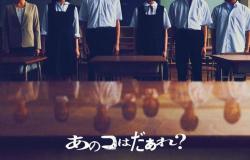We are looking forward to the 26th edition of the Udine event which is an unmissable event for fans of oriental cinema and for all those who still want excitement in a cinema. Here’s what we saw.
If it is true that, for those who regularly attend them for work or passion, returning to a festival year after year always gives a vague sensation of déjà vu, return to Far East Film Fest after many, too many years of absence it gave me a strange feeling. Everything, apparently, was exactly as I had left it: the Teatro Nuovo Giovanni da Udine, the colorful and imaginative displays, the camel troops of oriental cinema enthusiasts (the historical ones, with the addition of new generations), the participation of the city, the festive air, the ability of the organizers to package their event, and the films that are presented, with music, presentations, lively and enthralling and intriguing tones for the public.
Nothing seemed to have changed: there was still the small tavern in front of the theatre, where you can refresh yourself with a canapé and a glass of wine between one film and another (which also had new, happy management); and he was still wandering around in the foyer Marco Müller, today the new director of Taormina, busy greeting with a smile the many friends he has among the numerous guests of the FEFF. That nothing has (apparently) changed is the best possible confirmation that the FEFF formula worked then and continues to work todaywith a less superficial look we can see that However, the Udine festival dedicated to popular oriental cinema has grown: compared to many years ago, there is one more room, that of the Visionary, and then initiatives, meetings, workshops and opportunities that tell of a dynamic reality, and not at all passively identical to itself.
However, what is necessary to reflect on, more than the festival that contains it, is the cinema that was presented there. While the FEFF grew to respect its identity, over the last quarter of a century there have been many radical transformations in the galaxy of oriental cinema. If originally the beating heart of the FEFF was closely linked to the most beautiful cinema in the world in those years, that of Hong Kong, year after year the Udine event recorded and represented the perceptible and less perceptible movements that led, for example , to the decline of the cinema of the former British colony and the birth of Korean industrial and artistic domination, but also the many travails of Japanese cinema, or the emergence of realities such as Indonesia, Thailand, Malaysia. In short, the FEFF has always been a litmus test for the state of things, and still isdespite now having to live in a context in which there are many festivals which, paradoxically thanks to what was done in Udine, have now opened their eyes and ears and turned their attention to the East, thus representing more fierce competition than that of the past .
YOLO: from China with exuberance
What state of affairs did we encounter, then, over the course of three days spent at the FEFF? First of all, as the film chosen for the opening of the 26th edition of the festival told us, YOLOof a Chinese cinema which has brought its level of industrial and commercial maturation to levels of extreme sophistication.
Directed and starring Jia Ling, star of Chinese comedy here in his second test behind the camera, YOLO tells in extreme summary the story of a depressed and overweight thirty-year-old who, after the breakup with her family, and a series of more or less fortunate encounters, finds in the passion for boxing the key to a redemption which obviously passes through an extraordinary physical transformation, but which is first of all a character and existential metamorphosis. Of course, in the film it is remarkable that Jia Ling deliberately gained twenty kilos to play the role of the protagonist, only to then lose fifty during filming and revolutionize her physique, and even more remarkable is the fact that the film has currently grossed equivalent of 480 million dollars; what is striking, however, is YOLOis the ability to be popular cinema in a brazen and, in its own way, refined wayconstantly mixing registers (from comedy to drama, through sports movies) and accumulating a quantity of cues and ideas which, in other markets, would have been diluted in at least half a dozen different films. Here, however, there is a taste for creative waste, for narrative exuberance, which should in some way be taken as an example.
Hong Kong between past and future
On the Hong Kong front, things are complicated: the cinema of the former colony is increasingly subjected to the political, financial and even creative weight of mainland China, and seems to struggle to rediscover the creative dynamism of the past. If there are still them Herman Yau of films that are enjoyable but not at all original like Moscow Missionwho try to keep alive a flame of continuity with a glorious past and to move towards the future, here are the new names on the local scene trying to explore new territories.
Laurence Kanwith In Broad Daylighttackles the journalistic drama, in which the star Rachel Leung plays the role of an investigative reporter who tries to tell the horrors and violence suffered by the residents of a center that welcomes the elderly and disabled: Kan’s is a classic, almost Hollywood film, far too moderate and balanced in its tonesand which by emphasizing the role of investigative journalism, indirectly touches the sore point of increasingly limited press freedom in today’s Hong Kong. Jonathan Li his movie, Dust to Dust, shoots it directly in China, and with Chinese funds, reconstructing a famous news case (an armed robbery that caused numerous victims in 1995) and telling of a policeman’s twenty-year hunt for the person responsible for that robbery. On one side he puts a star from the former colony, Lam Ka-tungon the other the Chinese star From Peng (someone who comes from comedy, here in a very dramatic role), and this meeting-clash is in some way the symbol of two different ideas and traditions of cinema that seek a moment of synthesis. A synthesis that Li, however, finds only in part, in a film whose qualities are diluted a little too much in an excessive running time and in a structure that is all too traditional and linked to authorial models far from the traditions of HK.
Korea comes to terms with history
From what was screened in the first days of the FEFF, lhe Korean battleship confirms all its cinematic powerand also the desire to use cinema to deal with the history of the country.
Self Smugglersthe story of some smugglers in the 1980s, halfway between grotesque comedy and action thriller, turned out to be a completely negligible title, and so, in different ways, Ransomed And 12.12 The Day they are gods large productions designed for the wider public as solid from an industrial point of view as they are limited in terms of creative and artistic ideas.
Directed by Kim Seong-hun (that of A Hard Day and the Netflix series Kingdom) Ransomed tells the story (true, more or less) of an official of the Korean Foreign Ministry who, in 1987, leaves for Beirut torn apart by civil war with the unofficial task of paying the ransom needed to free a fellow countryman diplomat who he had been kidnapped more than a year earlier in the Lebanese capital. Medium tense, decidedly dynamic, based on a consolidated mix of action and humor with the addition of a sprinkling of drama, embodies contemporary Korean cinema at its bestthe one capable of solid, interesting but perhaps not particularly memorable films.
However, there is no trace of humor in the 12.12: The Day by Kim Sung-soo, grandiose, too grandiloquent and a little turgid reconstruction of the attempted coup d’état which took place in 1979 in Korea, in the aftermath of the assassination of President Park, at the hands of General Chun Doo-gwang. Politically and tactically intricate, but precise, Kim’s film stands out above all for the performances of the protagonists: Hwang Jung-min in those of Chun, and Jung Woo-sung in those of General Lee, his main opponent and, in some way, savior of the country.
Explosive Indonesia
In an edition of FEFF in which the focus on Indonesia was clear and declared, then it is worth mentioning the passage of 13 Bombs, a pure action thriller directed by the young Angga Dwimas Sasongko, one of the leading names of new Indonesian cinema. Too long, often too much dialogue, with a cast and performances that are on average lame to be generous, 13 Bombs, however, has the courage on its side to pursue an idea of uncompromising action, made up of explosions, physical stunts, hand-to-hand combat and tactical firefights, and of combine everything with a plot which, although perhaps a little haphazard, has the advantage of touching on contemporary and very topical issues for the Asian country and for the whole world: from terrorism to cryptocurrencies, but above all inequalities created by the global financial-capitalist system and the unbearable distance that is being created between the increasingly rich and the increasingly poor in the world. It should also be underlined how, in a film where the stories of terrorists and anti-terrorism forces mix with those of two nerds who own a start-up specialized in digital currencies, and which in any case in terms of form and content would be readable as typically “masculine” “, is the role of at least three female characters of the highest level, and anything but passive, including that of a girl who shows off a curious drawer Louise Brooks.






